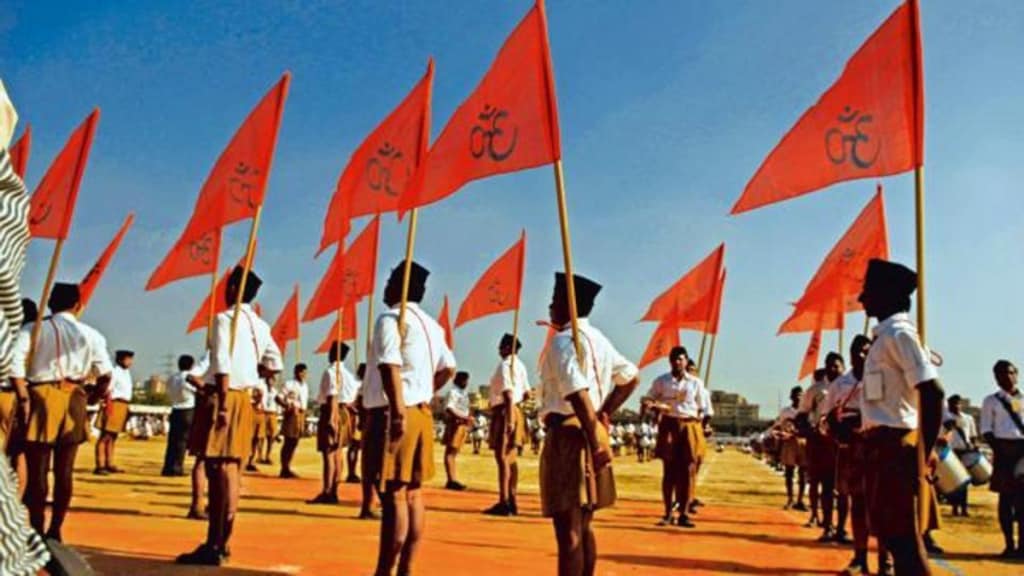By Badri Narayan
The Rashtriya Swayamsevak Sangh (RSS) began its centenary celebrations recently. The Sangh and its sympathisers are organising various programmes related to the RSS and its schemes for the India of the future. In these programmes, various aspects and meanings of the Sangh in Indian society are being discussed. These apart, they are producing other appreciative as well as critical discourses, triggering interpretations of its past and present.
On October 1 in Delhi, at an event linked to the celebrations, Prime Minister Narendra Modi highlighted the RSS role in the making of the Indian society and nation. He highlighted how in the Sangh’s shakhas (branches), an individual’s journey from “me” to “we” begins. As we know, Modi was a karyakarta (functionary) and pracharak (missionary) for a long period of his life. Therefore, what he shared on that occasion mostly emerged from his own experience.
As was observed several times during his chief ministership of Gujarat and as the prime minister, Modi has reiterated how he has learnt from the Sangh about the many aspects of life as well as a method of governance. He has imbibed from the RSS many constituents of his development vision as well as his practices to achieve samrasta (harmony) and equality. He has developed the notion of samagra samrasta (holistic harmony) that blends his experiences and learnings.
Two principal issues crop up in any discussion on the RSS—Hindu Rashtra and the relationship between Hindutva and development. The notion of Hindu Rashtra that emerges from the periodic deliberations of Sangh pracharaks and ideologues attracts wide attention of thinkers, political analysts, and a section of the public. Drawn from scattered, fragmented discourses, it offers a nuanced idea of a polity that can be perceived as inclusive, and not based on any religion-based segregation of primary and secondary citizens as highlighted by its critique. In such a Hindu Rashtra, the concept of “Hindu” is central. According to the Sangh interpretation, Hindu as a religion and culture in a contemporary sense is all-inclusive, resists religious hierarchies, and believes in a developing, democratic, and dialogical relation between religions. It proposes a happy, prosperous, and contented society, containing three foundational elements—samata (equality), mamata (compassion), and samrasta. There is no official blueprint of a Hindu Rashtra with the Sangh, but it appears constantly in discussions.
As regards the second issue, Hindutva is usually perceived either as a spiritual-religious entity or a discourse centred on religious identity. However, in the context of the Sangh, it does not merely imply a spiritual-religious discourse but also includes the vision of a social, national reconstruction.
So in this context, Hindutva also deals with a holistic development of society and nation. The Sangh tries to explore our Vedic, Puranic, and folk discourses for a sukhi and santusht (happy and contented) society. Our ancient literature proposes a society that cares for everyone—men or women, rich or poor. It cares for not merely human but also the elements of nature—such as kshitij (horizon), jal (water), pawak (fire), and samira (air)—as mentioned in the Ramayana. The purity and balance of these elements forges the nature or universe. So, Hindutva-based development as a concept is sensitive towards ecology and nature from the very beginning. It has become especially relevant in the context of a growing ecological crisis resulting from aggressive modernity fuelled by the Western society and power.
The RSS emphasis on a panch parivartan (five changes) seeks a sense of sva (self-hood) with bharatiya (Indian) values. Besides the right family values and promotion of social harmony, they inspire people to adopt an environment-friendly lifestyle and perform civic duties, as explained by the Sangh publicity head, Sunil Ambekar, recently. The Sangh also proposes a notion of development that is not merely anthropocentric but also cares for other living beings. In that sense, a notion of non-competitive and non-violent development appears as a central tenet for the Sangh. This argues for value-based development, which is different from a Western notion of consumerist development primarily. It proposes not merely economic development but also one that is oriented towards cultural development. Thus, a Hindutva lens argues for holistic development that encompasses materialistic development to accommodate concerns for nature, culture, and value. In the RSS interpretation of development, there is room to evolve sustainability in the real sense. This notion of development is centred on the concerns that emerge from a continuous dialogue between the past, present, and future. While proposing such a way forward, the Sangh also addresses everyday issues concerning our society. That is why it takes various initiatives to resolve social problems and remove structural inequalities. Through its social services, the Sangh tries to develop a capacity to aspire among the most marginal sections. This helps the people to acquire upward mobility and prepares them to move on the path of development. In the process, the Sangh is attempting to create the conditions for development that will allow us to achieve the mission of Viksit Bharat (developed India).
Hindutva, as defined by the RSS, is not merely a religious identity-based social movement. It aims to facilitate India’s march towards its goals of development. The Sangh and its various allies work among the poorest, marginalised, and vulnerable social groups to create the basic conditions to acquire a level from where they can move towards development-oriented goals. It does not merely work on religious issues but also engages with secular development schemes. It has also evolved from being a reformist charitable organisation to weave the diverse threads of India’s social mosaic. As described by RSS general secretary Dattatreya Hosabale, the Sangh-led Hindutva is meant to build a happy, prosperous, and equal India. This aspiration is a signal of the Sangh’s agenda.
The author of this article is the Vice Chancellor of the Tata Institute of Social Sciences, Mumbai.
Views are personal

